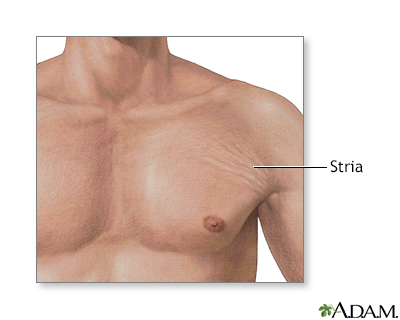Stretch marks
Striae; Striae atrophica; Striae distensae
Stretch marks are irregular areas of skin that look like bands, stripes, or lines. Stretch marks are seen when a person grows or gains weight rapidly or has certain diseases or conditions.
The medical name for stretch marks is striae.
Images



Considerations
Stretch marks can appear when there is rapid stretching of the skin. The marks appear as parallel streaks of red, thinned, glossy skin that over time become whitish and scar-like in appearance. Stretch marks may be slightly depressed and have a different texture than normal skin.
They are often seen when a woman's abdomen gets larger during pregnancy. They can be found in children who have become rapidly obese. They may also occur during the rapid growth of puberty. Stretch marks are most commonly located on the breasts, hips, thighs, buttocks, abdomen, and flank.
Causes
Causes of stretch marks may include any of the following:
- Cushing syndrome (disorder that occurs when the body has a high level of the hormone cortisol)
- Ehlers-Danlos syndrome (disorder marked by very stretchy skin that bruises easily)
- Abnormal collagen formation, or medicines that block collagen formation
- Pregnancy
- Puberty
- Obesity
- Overuse of cortisone skin creams
Home Care
There is no specific care for stretch marks. Marks often disappear after the cause of the skin stretching is gone.
Avoiding rapid weight gain helps reduce stretch marks caused by obesity.
When to Contact a Medical Professional
If stretch marks appear without a clear cause, such as pregnancy or rapid weight gain, call your health care provider.
What to Expect at Your Office Visit
Your provider will examine you and ask about your symptoms, including:
- Is this the first time that you have developed stretch marks?
- When did you first notice the stretch marks?
- What medicines have you taken?
- Have you used a cortisone skin cream?
- What other symptoms do you have?
If the stretch marks are not caused by normal physical changes, tests may be done. Tretinoin cream may help reduce stretch marks. Laser treatment may also help. In very rare cases, surgery may be done.
Related Information
DiabetesReferences
James WD, Elston DM, Treat JR, Rosenbach MA, Neuhaus IM. Abnormalities of dermal fibrous and elastic tissue. In: James WD, Elston DM, Treat JR, Rosenbach MA, Neuhaus IM, eds. Andrews' Diseases of the Skin. 13th ed. Philadelphia, PA: Elsevier; 2020:chap 25.
Patterson JW. Disorders of collagen. In: Patterson JW, ed. Weedon's Skin Pathology. 5th ed. Philadelphia, PA: Elsevier Limited; 2021:chap 12.
BACK TO TOPReview Date: 6/7/2023
Reviewed By: Elika Hoss, MD, Assistant Professor of Dermatology, Mayo Clinic, Scottsdale, AZ. Also reviewed by David C. Dugdale, MD, Medical Director, Brenda Conaway, Editorial Director, and the A.D.A.M. Editorial team.

Health Content Provider
06/01/2025
|
A.D.A.M., Inc. is accredited by URAC, for Health Content Provider (www.urac.org). URAC's accreditation program is an independent audit to verify that A.D.A.M. follows rigorous standards of quality and accountability. A.D.A.M. is among the first to achieve this important distinction for online health information and services. Learn more about A.D.A.M.'s editorial policy, editorial process and privacy policy. A.D.A.M. is also a founding member of Hi-Ethics. This site complied with the HONcode standard for trustworthy health information from 1995 to 2022, after which HON (Health On the Net, a not-for-profit organization that promoted transparent and reliable health information online) was discontinued. |
The information provided herein should not be used during any medical emergency or for the diagnosis or treatment of any medical condition. A licensed medical professional should be consulted for diagnosis and treatment of any and all medical conditions. Links to other sites are provided for information only -- they do not constitute endorsements of those other sites. © 1997- 2025 A.D.A.M., a business unit of Ebix, Inc. Any duplication or distribution of the information contained herein is strictly prohibited.
